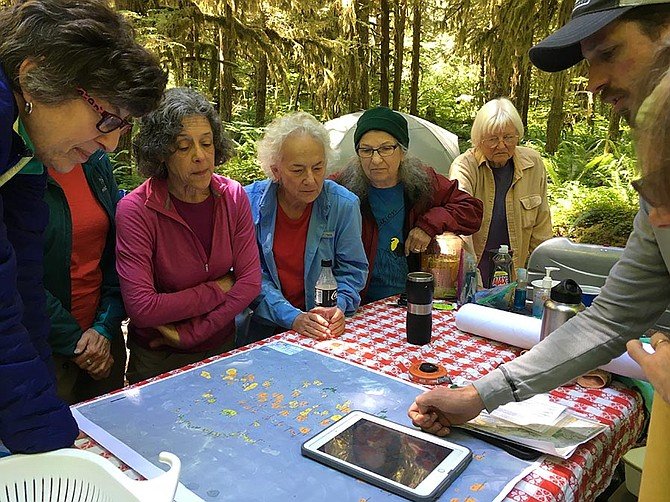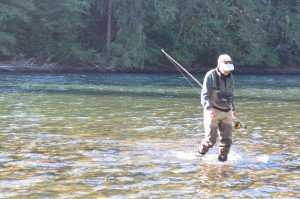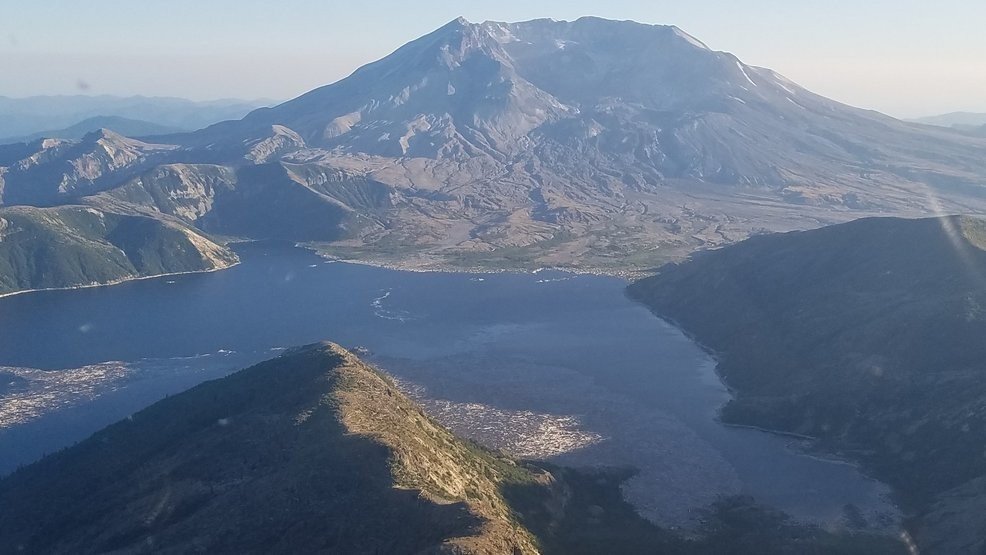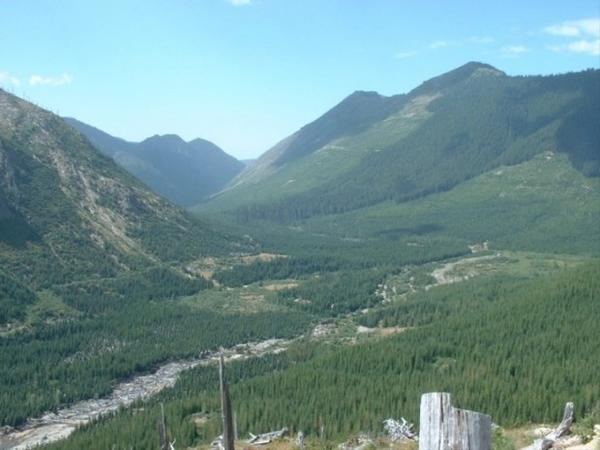[vc_row row_type=”row” use_row_as_full_screen_section=”no” type=”full_width” angled_section=”no” text_align=”left” background_image_as_pattern=”without_pattern” css_animation=””][vc_column width=”1/12″][/vc_column][vc_column width=”5/6″][vc_separator type=”normal” color=”#444444″ thickness=”3″][vc_column_text]
Big Tree Hunting in the Gifford Pinchot Nat’l Forest
[/vc_column_text][vc_separator type=”normal” color=”#444444″ thickness=”3″][vc_column_text]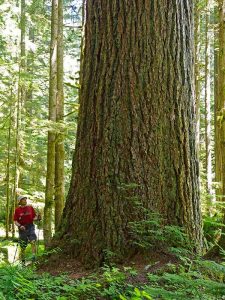
Brothers Darryl and Darvel Lloyd, both CFC members, recently wrote a guest blog post for us highlighting some giant trees in the Gifford Pinchot National Forest. They’ve been searching for and tracking these trees for years and are local experts. Did you know, for example, that the GPNF contains the largest known Noble Fir?
Check out their post here (with plenty of photos). We also want to thank Darryl and Darvel as well as Friends of Mount Adams for supporting the Cascade Forest Conservancy’s conservation programs.[/vc_column_text][vc_empty_space][vc_separator type=”normal” color=”#444444″ thickness=”3″][vc_column_text]
Northwest Old-Growth Forest: Carbon Storage Stars
[/vc_column_text][vc_separator type=”normal” color=”#444444″ thickness=”3″][vc_column_text]Lush, old-growth, conifer forests are an iconic feature of the Pacific Northwest. Large, magnificent trees and brilliant shades of green bring people from near and far to these forests to recreate. Pacific Northwest old-growth forests are beautiful backdrops for recreation, but they also have an important role in mitigating climate change impacts. The Gifford Pinchot National Forest, which has several areas of low elevation mature and old growth forests, is ranked fourth in the nation for carbon storage. Old forests absorb more carbon than young forests because there is a complex ecosystem, with each plant, animal, and fungi playing a role in carbon storage. As part of our climate resilience blog series, we are highlighting information on old-growth forests and carbon storage presented in our Wildlife and Climate and Resilience Guidebook. Check out the full article here:
https://cascadeforest.org/northwest-old-growth-forests-carbon-storage-stars/[/vc_column_text][vc_empty_space][vc_separator type=”normal” color=”#444444″ thickness=”3″][vc_column_text]
Green River one of America’s “Most Endangered”
[/vc_column_text][vc_separator type=”normal” color=”#444444″ thickness=”3″][vc_column_text] CFC’s Policy and Campaign Manager, Nicole Budine, recently wrote a guest blog post for American Rivers, who just this year designated the Green River as one of the nation’s most endangered rivers. This special place is under threat from a mining proposal and we need your help to stop it: www.cascadeforest.org/nomine
CFC’s Policy and Campaign Manager, Nicole Budine, recently wrote a guest blog post for American Rivers, who just this year designated the Green River as one of the nation’s most endangered rivers. This special place is under threat from a mining proposal and we need your help to stop it: www.cascadeforest.org/nomine
Here’s the link to the blog post at American Rivers.[/vc_column_text][vc_empty_space][vc_separator type=”normal” color=”#444444″ thickness=”3″][vc_column_text]
Alert – Help Us Stop the Clearcutting Bill!
[/vc_column_text][vc_separator type=”normal” color=”#444444″ thickness=”3″][vc_column_text]If you like trees, we need your help. Congress is about to pass the worst forestry bill we have ever seen; a bill that would theoretically allow clearcutting of areas up to 50 square miles and exempt these decisions from almost all public and environmental review. If this makes you angry, please tell your U.S. House Representative what you think about this irresponsible and misnamed bill, HR 2936, the Resilient Federal Forests Act of 2017.
.jpg)
House Republicans already passed HR 2936 through committee, and they are expected to vote this through any day now. We need our Republicans, like Rep. Jamie Herrera Beutler, to reject their party’s ill-advised plans, and we must make sure no Democrats end up supporting this bill. Please contact your Representative directly today (phone numbers listed at
www.contactingcongress.org), and consider writing a letter to the editor in your local paper, directly naming your Representative – so that your message about HR 2936 ends up directly on his or her desk. Talking points and more info at
https://cascadeforest.org/defend-public-lands-from-lawless-logging/Thank you — we need everyone to pitch in to save the future of our national forests![/vc_column_text][vc_empty_space][vc_separator type=”normal” color=”#444444″ thickness=”3″][vc_column_text]
We’re on Instagram!
[/vc_column_text][vc_separator type=”normal” color=”#444444″ thickness=”3″][vc_column_text]
In case you thought we weren’t hip enough already, Cascade Forest Conservancy is
now on Instagram! We’re posting beautiful shots from our favorite places, and encourage members and friends to follow us and share photos. If you visit the Gifford Pinchot National Forest, send us a picture and we’ll put it up, or tag us @CascadeForest
[/vc_column_text][vc_empty_space][vc_separator type=”normal” color=”#444444″ thickness=”3″][vc_column_text]
CFC Gala is Coming Up: Join Us Nov. 2
[/vc_column_text][vc_separator type=”normal” color=”#444444″ thickness=”3″][vc_column_text]Did you know that our fall banquet on November 2 is our biggest and most exciting event of the year? Come celebrate a year of challenges and successes with us on November 2 at the Melody Ballroom in Portland! You’ll enjoy delicious food and drink, great deals and pleasant company – all while supporting CFC’s important conservation work. Check out the event website here for details and to sign up.
We’ll start things with a cocktail reception (open bar!) and silent auction at 5:30, followed by a dinner and live auction around 7:00. The auction is not to be missed. We have dozens of items and our guests are always going home with great deals on outdoor gear, artwork, wine and spirits, vacations, sports and theater tickets, and much more. The proceeds from this event are essential to our conservation programs — if you care about the forests, rivers, wildlife and communities of the Cascades, please consider joining us for this fun evening.
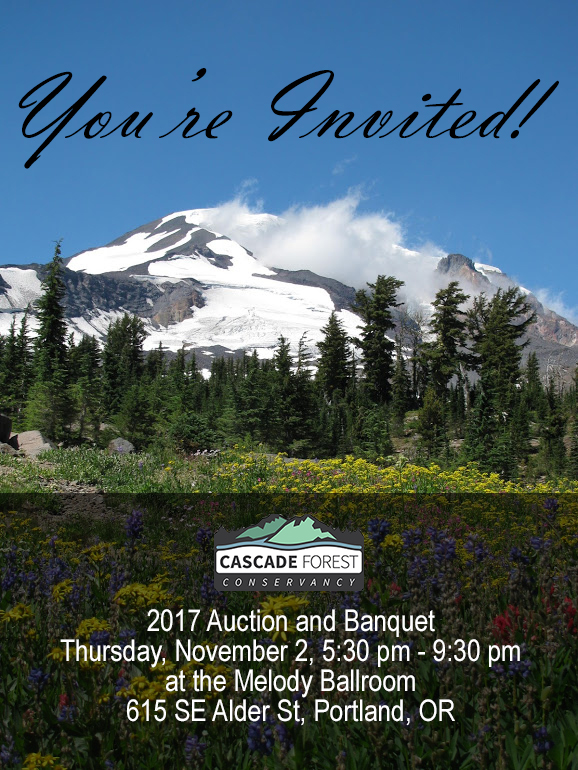 [/vc_column_text][/vc_column][vc_column width=”1/12″][/vc_column][/vc_row]
[/vc_column_text][/vc_column][vc_column width=”1/12″][/vc_column][/vc_row]





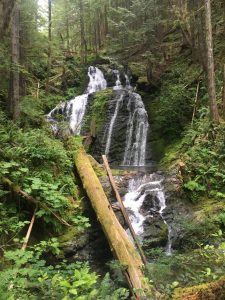
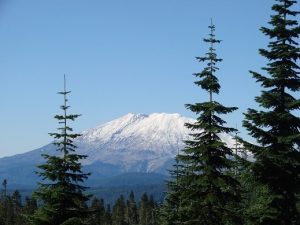 From old-growth forests to snow-covered alpine areas, Washington’s South Cascades are home to a variety of habitat types that support unique plant and animal populations. Connectivity throughout the landscape allows wildlife to move between habitat areas, enabling populations to be more resilient to a changing climate. Cascade Forest Conservancy has identified some of the key areas in the Gifford Pinchot National Forest that, with increased protections, would improve the ability of wildlife populations to move between patches of habitat and be more resilient to climate change impacts.
From old-growth forests to snow-covered alpine areas, Washington’s South Cascades are home to a variety of habitat types that support unique plant and animal populations. Connectivity throughout the landscape allows wildlife to move between habitat areas, enabling populations to be more resilient to a changing climate. Cascade Forest Conservancy has identified some of the key areas in the Gifford Pinchot National Forest that, with increased protections, would improve the ability of wildlife populations to move between patches of habitat and be more resilient to climate change impacts.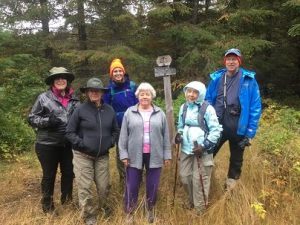
 Ballroom, and was a lovely evening. An array of silent auction items, the Wall of Beverages, the popular Heads & Tails bead game, the live auction, and the Dessert Dash were all a big hit with the crowd! This year’s Special Appeal, focusing on the Mt. St Helen’s mine campaign, was a great chance to support the important work that CFC does to protect the Gifford Pinchot National Forest from environmental degradation.
Ballroom, and was a lovely evening. An array of silent auction items, the Wall of Beverages, the popular Heads & Tails bead game, the live auction, and the Dessert Dash were all a big hit with the crowd! This year’s Special Appeal, focusing on the Mt. St Helen’s mine campaign, was a great chance to support the important work that CFC does to protect the Gifford Pinchot National Forest from environmental degradation.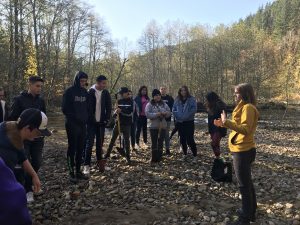 Evergreen High School and Heritage High School in Vancouver, WA and Robert Gray Middle School in Portland, OR participated in our Young Friends of the Forest program this October. Evergreen’s Environmental Science Class embarked on a wildlife camera survey where they helped set up the cameras and learned about animal track and scat identification. Classes from Robert Gray Middle School and Heritage High School assisted with the first stages of our beaver reintroduction project by assessing habitat suitability in wetlands and riparian areas. Each class also planted around 80 trees to improve aquatic habitat, increase bank stability and biodiversity, and create future forage for newly reintroduced beavers. A huge thank you to all the teachers and students involved with the projects this semester![/vc_column_text][vc_empty_space][vc_empty_space][vc_empty_space][vc_separator type=”normal” color=”#444444″ thickness=”3″][vc_column_text]
Evergreen High School and Heritage High School in Vancouver, WA and Robert Gray Middle School in Portland, OR participated in our Young Friends of the Forest program this October. Evergreen’s Environmental Science Class embarked on a wildlife camera survey where they helped set up the cameras and learned about animal track and scat identification. Classes from Robert Gray Middle School and Heritage High School assisted with the first stages of our beaver reintroduction project by assessing habitat suitability in wetlands and riparian areas. Each class also planted around 80 trees to improve aquatic habitat, increase bank stability and biodiversity, and create future forage for newly reintroduced beavers. A huge thank you to all the teachers and students involved with the projects this semester![/vc_column_text][vc_empty_space][vc_empty_space][vc_empty_space][vc_separator type=”normal” color=”#444444″ thickness=”3″][vc_column_text]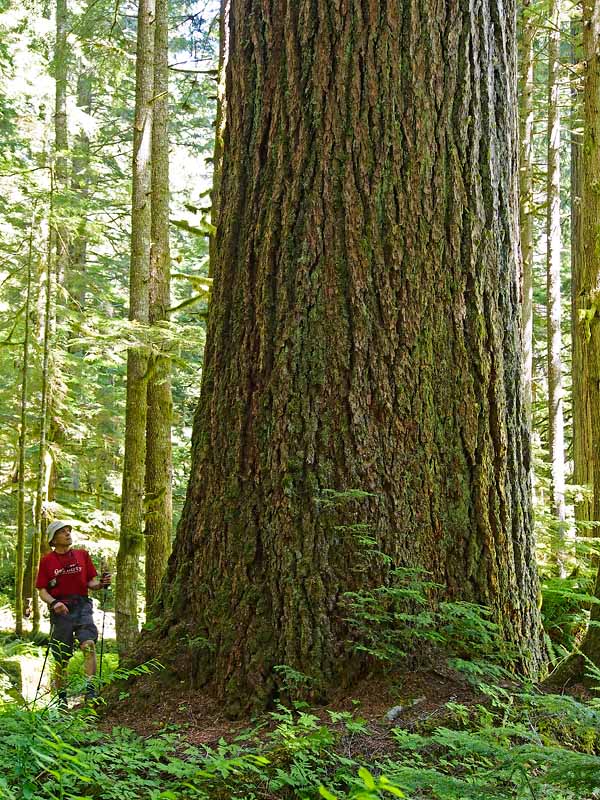

 CFC’s Policy and Campaign Manager, Nicole Budine, recently wrote a
CFC’s Policy and Campaign Manager, Nicole Budine, recently wrote a .jpg) House Republicans already passed HR 2936 through committee, and they are expected to vote this through any day now. We need our Republicans, like Rep. Jamie Herrera Beutler, to reject their party’s ill-advised plans, and we must make sure no Democrats end up supporting this bill. Please contact your Representative directly today (phone numbers listed at
House Republicans already passed HR 2936 through committee, and they are expected to vote this through any day now. We need our Republicans, like Rep. Jamie Herrera Beutler, to reject their party’s ill-advised plans, and we must make sure no Democrats end up supporting this bill. Please contact your Representative directly today (phone numbers listed at 

